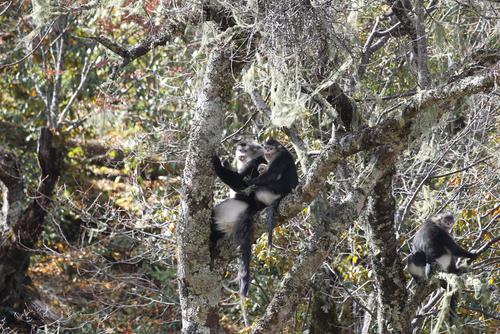当前位置:
X-MOL 学术
›
Ecol. Evol.
›
论文详情
Our official English website, www.x-mol.net, welcomes your feedback! (Note: you will need to create a separate account there.)
Surviving at the highest and coldest: Nutritional and chemical components of fallback foods for Yunnan snub‐nosed monkeys
Ecology and Evolution ( IF 2.6 ) Pub Date : 2024-04-16 , DOI: 10.1002/ece3.11219 Hao Pan 1, 2, 3 , Rong Hou 2 , He Zhang 2 , Yanpeng Li 1, 4 , Zhipang Huang 1, 3, 4, 5 , Liangwei Cui 5, 6 , Wen Xiao 1, 3, 4, 6
Ecology and Evolution ( IF 2.6 ) Pub Date : 2024-04-16 , DOI: 10.1002/ece3.11219 Hao Pan 1, 2, 3 , Rong Hou 2 , He Zhang 2 , Yanpeng Li 1, 4 , Zhipang Huang 1, 3, 4, 5 , Liangwei Cui 5, 6 , Wen Xiao 1, 3, 4, 6
Affiliation

|
Fallback foods (FBF), categorized into staple and filler types, are suboptimal food sources chosen by animals in response to a scarcity of preferred food items during specific periods. Using lichens as FBF by Yunnan snub‐nosed monkeys (Rhinopithecus bieti ) represents a distinctive ecological adaptation and evolutionary development within nonhuman primates. This study delves into the annual dietary choices of the species to address issues, elucidate the nutritional value, and understand the ecological significance of lichens for this primate species, which resides at the highest altitudes and experiences the coldest weather among global primates. The findings reveal that the lichens consumed by the monkeys serve as the staple FBF, with Bryoria spp. and Usnea longissima being the primary dietary species. The former is the preferred choice, providing higher digestible fiber (neutral detergent fiber) levels but lower tannin, fat, ADF, and energy levels. During the dry season, lichens dominate as the monkeys' primary food and nutritional resources. In the wet season, they act as a fundamental food selection rather than an ideal dietary choice, substituting nutrients from fruits, seeds, and leaves. Compared to other Asian colobine counterparts, this species exhibits the highest lichen consumption but the lowest proportions of leaves, flowers, and seeds. This study provides valuable evidence and information for developing or amending conservation strategies and guidelines for the dietary management of captive breeding of monkeys, one of the world's critically endangered primate species.
中文翻译:

在最高和最冷的环境下生存:云南金丝猴备用食物的营养和化学成分
后备食物(FBF)分为主食和填充物类型,是动物在特定时期因首选食物短缺而选择的次优食物来源。云南金丝猴利用地衣作为 FBF(金丝猴 )代表了非人类灵长类动物独特的生态适应和进化发展。这项研究深入研究了该物种的年度饮食选择,以解决问题,阐明营养价值,并了解地衣对这种灵长类动物的生态意义,这种灵长类动物居住在海拔最高的地方,经历着全球灵长类动物中最寒冷的天气。研究结果表明,猴子食用的地衣是 FBF 的主食,其中布赖奥里亚 种。和长松萝 是主要的饮食物种。前者是首选,可提供较高的可消化纤维(中性洗涤纤维)水平,但单宁、脂肪、ADF 和能量水平较低。在旱季,地衣是猴子的主要食物和营养来源。在雨季,它们充当基本的食物选择,而不是理想的饮食选择,替代水果、种子和叶子的营养。与其他亚洲疣猴相比,该物种的地衣消耗量最高,但叶子、花和种子的比例最低。这项研究为制定或修改猴子圈养繁殖的饮食管理保护策略和指南提供了宝贵的证据和信息,猴子是世界上极度濒危的灵长类动物之一。
更新日期:2024-04-16
中文翻译:

在最高和最冷的环境下生存:云南金丝猴备用食物的营养和化学成分
后备食物(FBF)分为主食和填充物类型,是动物在特定时期因首选食物短缺而选择的次优食物来源。云南金丝猴利用地衣作为 FBF(



























 京公网安备 11010802027423号
京公网安备 11010802027423号